Qi Cui
CHIP: Chameleon Hash-based Irreversible Passport for Robust Deep Model Ownership Verification and Active Usage Control
May 30, 2025Abstract:The pervasion of large-scale Deep Neural Networks (DNNs) and their enormous training costs make their intellectual property (IP) protection of paramount importance. Recently introduced passport-based methods attempt to steer DNN watermarking towards strengthening ownership verification against ambiguity attacks by modulating the affine parameters of normalization layers. Unfortunately, neither watermarking nor passport-based methods provide a holistic protection with robust ownership proof, high fidelity, active usage authorization and user traceability for offline access distributed models and multi-user Machine-Learning as a Service (MLaaS) cloud model. In this paper, we propose a Chameleon Hash-based Irreversible Passport (CHIP) protection framework that utilizes the cryptographic chameleon hash function to achieve all these goals. The collision-resistant property of chameleon hash allows for strong model ownership claim upon IP infringement and liable user traceability, while the trapdoor-collision property enables hashing of multiple user passports and licensee certificates to the same immutable signature to realize active usage control. Using the owner passport as an oracle, multiple user-specific triplets, each contains a passport-aware user model, a user passport, and a licensee certificate can be created for secure offline distribution. The watermarked master model can also be deployed for MLaaS with usage permission verifiable by the provision of any trapdoor-colliding user passports. CHIP is extensively evaluated on four datasets and two architectures to demonstrate its protection versatility and robustness. Our code is released at https://github.com/Dshm212/CHIP.
Steganographic Passport: An Owner and User Verifiable Credential for Deep Model IP Protection Without Retraining
Apr 03, 2024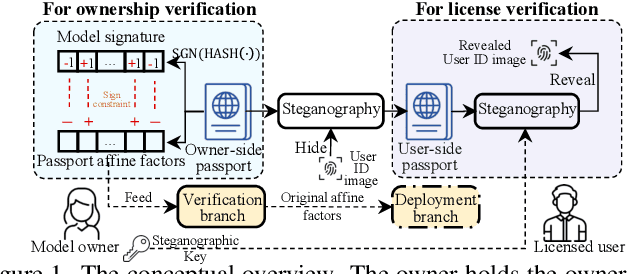

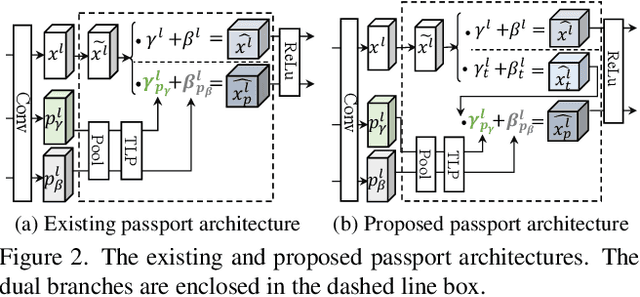
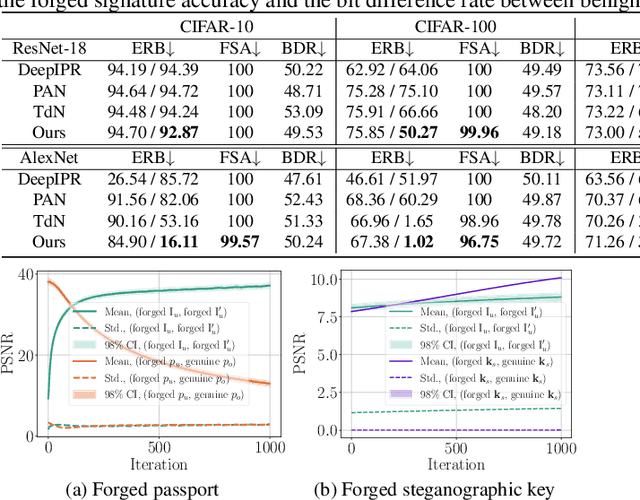
Abstract:Ensuring the legal usage of deep models is crucial to promoting trustable, accountable, and responsible artificial intelligence innovation. Current passport-based methods that obfuscate model functionality for license-to-use and ownership verifications suffer from capacity and quality constraints, as they require retraining the owner model for new users. They are also vulnerable to advanced Expanded Residual Block ambiguity attacks. We propose Steganographic Passport, which uses an invertible steganographic network to decouple license-to-use from ownership verification by hiding the user's identity images into the owner-side passport and recovering them from their respective user-side passports. An irreversible and collision-resistant hash function is used to avoid exposing the owner-side passport from the derived user-side passports and increase the uniqueness of the model signature. To safeguard both the passport and model's weights against advanced ambiguity attacks, an activation-level obfuscation is proposed for the verification branch of the owner's model. By jointly training the verification and deployment branches, their weights become tightly coupled. The proposed method supports agile licensing of deep models by providing a strong ownership proof and license accountability without requiring a separate model retraining for the admission of every new user. Experiment results show that our Steganographic Passport outperforms other passport-based deep model protection methods in robustness against various known attacks.
Traceable and Authenticable Image Tagging for Fake News Detection
Nov 20, 2022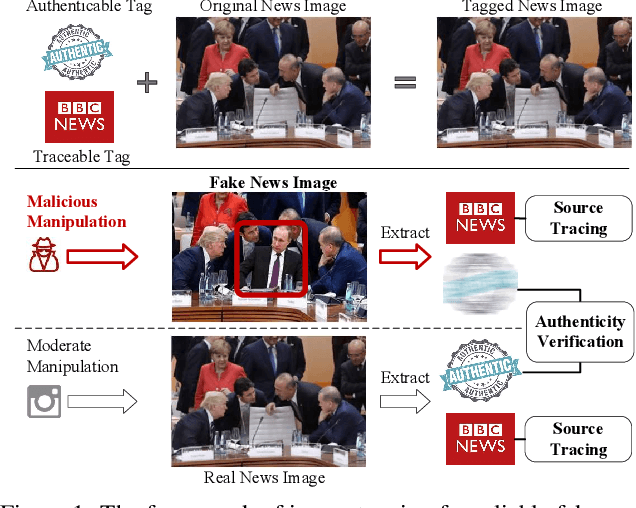

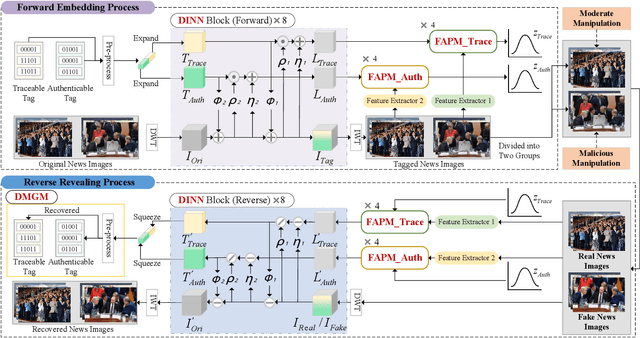

Abstract:To prevent fake news images from misleading the public, it is desirable not only to verify the authenticity of news images but also to trace the source of fake news, so as to provide a complete forensic chain for reliable fake news detection. To simultaneously achieve the goals of authenticity verification and source tracing, we propose a traceable and authenticable image tagging approach that is based on a design of Decoupled Invertible Neural Network (DINN). The designed DINN can simultaneously embed the dual-tags, \textit{i.e.}, authenticable tag and traceable tag, into each news image before publishing, and then separately extract them for authenticity verification and source tracing. Moreover, to improve the accuracy of dual-tags extraction, we design a parallel Feature Aware Projection Model (FAPM) to help the DINN preserve essential tag information. In addition, we define a Distance Metric-Guided Module (DMGM) that learns asymmetric one-class representations to enable the dual-tags to achieve different robustness performances under malicious manipulations. Extensive experiments, on diverse datasets and unseen manipulations, demonstrate that the proposed tagging approach achieves excellent performance in the aspects of both authenticity verification and source tracing for reliable fake news detection and outperforms the prior works.
 Add to Chrome
Add to Chrome Add to Firefox
Add to Firefox Add to Edge
Add to Edge